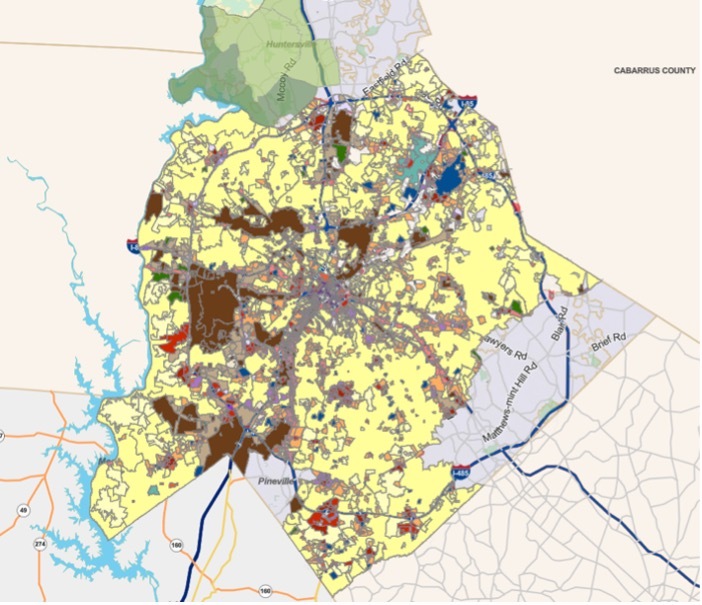- North Carolina’s urban counties are growing quickly, as is demand for new housing
- Zoning restrictions regulate property markets and artificially restrict the supply of new housing in our cities where it is most needed
- Because of the restricted supply of new housing, housing prices have skyrocketed, threatening future growth
North Carolina families feel pain at the pump, grocery store, and shopping malls. They are also feeling it as they pay their rent and mortgages — which is becoming a big issue in North Carolina as our population grows faster than new housing, especially in the state’s urban centers.
Fortunately, the issue has garnered bipartisan attention. Having so many competing interests at stake, however, makes it harder to arrive at solutions.
A recent Civitas poll found that 83% of likely North Carolina voters are concerned about the current price of housing. Though there are many factors involved, zoning laws are a primary contributor to the problem. Zoning has drawn new attention in recent years as our nation’s largest cities have been forced to address the housing supply shortage driving up the cost of housing. In North Carolina, we hope to preempt a housing debacle like that of San Francisco, where the average home costs over nine times more than the average income in the city.
1. Zoning May Preserve Current Property Use
According to a definition from the World Bank, “the purpose of zoning is to allow local and national authorities to regulate and control land and property markets to ensure complementary uses. Zoning can also provide the opportunity to stimulate or slow down development in specific areas.”
Zoning ordinances are a legal framework to guide the development of an area. Zoning is, therefore, often governed by a local authority.
Zoning may be strict due to the nature of the locality. For example, much of the Outer Banks is zoned for residential purposes. Skyrises or large hotels would alter the character of a place loved for its beach houses and natural landscapes, not its skylines. Local zoning guidelines may also support the upkeep of wildlife preservation areas. Even so, zoning might restrict economic growth in a high-demand area.
2. Zoning Restricts Housing Supply
Unfortunately, zoning has restricted the housing supply in North Carolina as it has done in many other states. New home building has still not yet reached the highs seen just prior to the 2008 recession. Though the population has boomed since then, housing has not kept up. Zoning artificially limits housing supply as it restricts the types and amount of housing in a given area. Having supply artificially limited leads to higher prices, making housing increasingly unaffordable for many families.
The below graph shows that despite our population growth, the supply of new housing has waned.
Figure 1. New housing in North Carolina since 2004

North Carolina is growing. Only four states surpassed North Carolina in terms of population growth in the last decade. This growth has predominately been in the state’s urban counties. According to the Office of State Budget and Management, “Population growth in North Carolina’s six urban counties accounted for 54% of the 951,000 people added between 2010 and 2019, with Mecklenburg and Wake Counties alone accounting for 38%.” These trends — more population growth and most of it occurring within the state’s urban counties — are expected to continue over the next decade.
Population growth can be a good thing — it results from our state being a desirable destination. Yet housing growth is failing to keep up, causing prices to skyrocket. Strict zoning restrictions that prevent cheaper housing options are often to blame.
In Charlotte, an estimated 84% of the residential land is zoned for single-family homes, seen in yellow in the below image. U.S. cities, on average, have just 64% of residential land zoned for single-family housing.
Multifamily districts are orange in the below graph. Examples of multifamily districts include attached dwellings such as larger apartment complexes and condominiums.
Figure 2. Residential zoning in Charlotte
Single-family districts are in yellow; multifamily districts are in orange

Source: Screenshot from charlotte.maps.arcgis.com
In Raleigh, 88% of the city’s residential land is zoned for single-family housing. The image below shows detached single-family zoning in pink. Other residential zoning is in teal.
Figure 3. Residential zoning in Raleigh
Single-family districts are in pink; other residential districts are in teal

Source: Screenshot from raleigh-residential-zoning.glitch.me
In Greensboro, North Carolina’s third-largest city, the majority of residential land is zoned for single-family housing. According to the local government’s website, “single-family residential is the largest single land use category, occupying nearly 31% of the city’s land area.” Over 41% of the city is undeveloped.
Figure 4. Residential zoning in Greensboro

Source: Screenshot from hub.arcgis.com
The good news is that this problem is fixable. Relaxing strict zoning restrictions would lead to a greater supply of housing.
3. Zoning Drives Housing Prices
With restrictive zoning reducing the supply of housing, prices are going up.
According to Zillow, home prices in Raleigh have risen 17% over the past year. The typical home now costs $447,961. In 2015, the typical home was less than $230,000.
Charlotte home prices are up 19% over the year. The typical home costs $399,218 today, more than double the 2015 average.
Greensboro home prices have risen 18% over the year. A typical home now costs $247,739, more than double the 2015 average.
People have been moving to North Carolina in droves because of our state’s economic growth, business-friendly environment, relatively affordable cost of living, comparably low taxes, natural landscapes, and temperate climate.
Egregious housing prices threaten the economic and population growth that has drawn so many to our state. Affordable housing close to one’s place of work is crucial to a family’s financial welfare and well-being.
North Carolinians are concerned about the price of housing. Luckily, this issue has garnered significant attention.
“I think the purpose of zoning is to prevent harm,” Andrew Whittemore, associate professor in the Department of City and Regional Planning at the University of North Carolina in Chapel Hill, told The New York Times. “Planners shouldn’t be wealth managers. But they effectively are in every municipality in the country.”
Government should not be in the business of managing wealth. But by effectively raising housing prices through restrictive zoning, the government helps determine who comes into a community and who doesn’t. Too often, zoning excludes many families that otherwise would have come to the area.
Our state’s increased population growth demonstrates its desirability. Government should not be an obstacle for those who want to live in North Carolina. Loosening restrictive zoning regulations at the local level is one way to allow our state’s housing supply to grow alongside demand.

